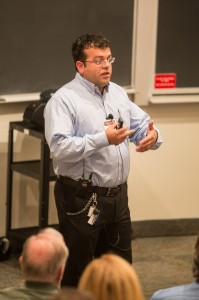Ugo A. Perego said people often wonder how he can sleep at night as a geneticist and member of the church.
“I don’t sleep at night but that’s because I have crying kids,” Perego said.
Perego is an Italian-born geneticist who has done extensive work on the genetics of migrations, genealogies, ancestry and history—particularly Book of Mormon history. Perego has also served in many capacities in the church, including serving in a bishopric and teaching seminary. Friday, he gave a presentation titled “Science and Religion: Can they coexist?”
He posed a question to a packed room of Education Week participants in the Benson Building: Can religion and science coexist?

“Think about the question. Now, pray for my soul,” Perego said prompting cheers and laughs.
Perego then presented genetic history behind modern humans, homo sapiens sapiens, and Neanderthals, homo sapiens neanderthalensis, to explain the interaction of colonizing groups and host groups.
Often, colonizing groups are at a disadvantage to a host group because host groups have a stronger genetic predisposition to their environment because of natural selection, or the genetic refining of the species to an environment over time.
Perego cited this as a possibility of missing genetic answers to the peoples of the Book of Mormon. Often, genetics of a colonizing group are disposed not to propagate as well as a host group. If they do not replace the host group, a colonizing group can disappear completely.
He also said there are several aspects of modern human and neanderthal genetic theory that are fluid. There are several points of discussion that are far from settled, like genetic similarities or interactions between the two species. These theories have also changed over time.
This is not dissimilar to a spiritual journey according to Perego.
“What you feel about the purpose of life or Heavenly Father is different now than what you felt ten years ago, 20 years ago, 50 years ago,” Perego said.
Perego said that science and religion represent two different source of knowledge, citing D&C 88:118 as a call to seek knowledge from “study” and “faith.”
He also saith that science and the scientific method are adequate for exploring phenomena in nature, but are not compatible for exploring questions of spirituality because science seeks to explain how while spirituality seeks to explain why.
The two ideas seem incompatible because of the different usage of terms in science. Perego specifically noted the difference in the use of the term “theory.” To a scientist, a theory is a scientifically acceptable body of principles that are supported by evidence. But the layman often thinks that theory is an abstract concept based on hypothetical facts.
Perego said that several church leaders have made statements that say that science and religion can coexist, particularly quoting Brigham Young as saying that “there is no true religion without true science . . . and not true science without true religion.”
“A legitimate conflict between science and religion cannot exist,” Perego said, reading a quote from Albert Einstein. “Science without religion is lame, religion without science is lame.”




